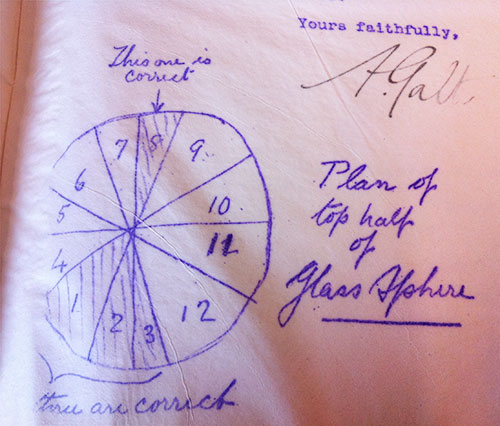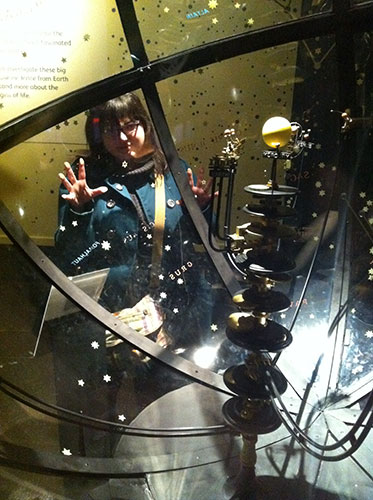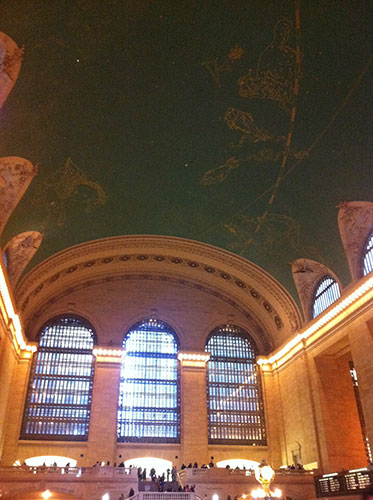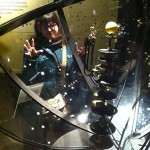Jupiter is OWNING the night sky right now. Seriously – check it out – it’s like you can reach out and touch it. On a clear night, look up. That big thing you think is Jupiter? It’s totally Jupiter. You can watch it cross the sky as it moves through the ecliptic (that plane the planets appear to spin round on like a hula hoop) and marvel at the awesomeness of space. I’m a big fan of space. Can you tell?
If you love space too, and the clouds are cramping your style, you can do what I do whenever I’m in Edinburgh – visit the Sendtner Orrery.
You know the orrery? It’s in the Earth in Space gallery at National Museum of Scotland. An orrery is a model of the solar system and it’s named after the 4th Earl of Orrery. (I always wonder if some kind of etymological hat trick could be achieved by eating a sandwich while wearing wellies and looking at the orrery.)
The Sendtner Orrery is always my first stop at the museum. It was made by Mr. Michael Sendtner of Munich, Germany, and has just finished its run as Object of the Month to mark its centenary.

I was first drawn to this awesome little planetarium when I noticed the description on the front of the object:
“Made in 1912-13, the orrery does not include Pluto, which was not discovered until 1930. However, since Pluto was demoted to the status of ‘dwarf planet’ in 2006, the orrery is up-to-date again.”
When I started doing research for my 1913 project, I remembered the orrery and wanted to find out more about it. It was such a cool thing with a quirky sign. How did it work? Why did the museum want to commission it specially? Did they congratulate themselves when they installed it?
“Great orrery, folks! Good work! Well, that’s all the planets done. Let’s get ourselves a T.rex, shall we?”
How annoyed were they when Pluto was discovered in 1930?
(It was on my mind, because my research told me that the Woolworth Building was the tallest and most opulent skyscraper in the world when it was completed in 1913, but it was usurped by the Chrysler building just a mile or two up Manhattan Island, also in 1930.)
For all of the National Museums Scotland curators over the past century, what must it have felt like to be in charge of an expensive, specially commissioned, permanent exhibition that was MISSING A PLANET?
How professionally smug could one allow oneself to feel in 2006, when Pluto was officially demoted?
When I read the sign, I remember thinking, Now THAT’S a curator who likes accuracy!
I vowed to meet the current curator and see if I could find out more.
Okay, so it turned out that I didn’t need to do anything as dramatic as vow to meet the curator – I just had to email her and arrange a visit.
A few weeks later I found myself talking to Tacye Phillipson, Curator of Science, and she was signing me into the bit of the museum that is not normally meant for the public. Before I found out that ‘behind the scenes’ consisted of offices, archives and a fairly typical looking break room, I pretended I was Nicholas Cage in National Treasure (the bit where he’s going on about the importance of preserving historical artefacts – not the bit where he’s wanted for treason).
We were about to look at the museum’s acquisition archives. These were big old books of letters. Now I was imagining I was June Brown in Who Do You Think You Are. (I had to wash my hands, but unfortunately I didn’t get to wear little white cotton gloves and I was kind of disappointed.)
As we started to look through all the correspondence and documentation related to the orrery, I began to discover something about the character traits of people who enjoy working in museums.
It turns out all curators like accuracy. It’s a pretty major component of what they do.
Take the curator who did the acquisition in the first place – Dr. Alexander Galt. He thought it would be pretty straightforward, but it took two long years and a series of politely irate correspondence before the orrery was finally entered into the acquisition book.
What happened? According to the letters, there were delays, corrections, edits, malfunctions, and a particularly galling accusation from Mr Sendtner that the museum staff had failed to pack the orrery away for safe travel!
Dr. Galt’s reply to that particular missive retains a thin veneer of civility, but the subtext, clearly, is We are archivists! Packing things away safely is one of the two main things we DO! The other, by the way, is displaying them accurately, so could you perhaps proofread your planets and try again, because we have some very excited children and adults here waiting for the word ‘nerd’ to be invented and for the ORRERY to arrive! (I may be taking liberties with the subtext here. But read the letters yourself. They’re fascinating, and the museum has scanned and uploaded them. You can find them at the link above.)
He just about contains his near-apoplexy later in the year when most of the stars are painted onto the surface of the orrery in the wrong order. He resorts to tersely worded diagrams.

The final product is a gorgeous piece of mechanical engineering in a beautiful glass and metalwork sphere. It’s so steampunk it hurts. It’s humbling to see the solar system in miniature, and to know how much effort went into getting it here. Was it worth all that trouble to get it right? Yeah. If it’s going on display in a museum, it’s got to be. We can’t have everyone thinking space is the wrong way round. How would you ever find Jupiter?

If you think Dr. Galt is hardcore, though, consider the curators who demand precision outside their jurisdiction. Take Neil deGrasse Tyson, Director of the Hayden Planetarium in New York, and astrophysics superstar. He appreciates the importance of sub-editing space, and is a stickler for astronomical accuracy. Good on him.
In one of his recent podcasts, he recommended that visitors to his city take a tour of all the ‘cosmic iconography’ in New York. Give it a listen – it’s a great episode. Here’s the science bit:
“…you go into Grand Central Terminal and look up. There is the night sky as imagined by people at the time, who put the sky on the dome. Except the stars are BACKWARDS. That… just… yeah… just DON’T get me started. Okay? Backwards, and Orion the Hunter, is facing forwards. In this field of backwards stars.”

He’s right. I’m from New York, and since the ceiling was restored in 1998 I’ve had the opportunity to pass through Grand Central many times. Whenever I’m there, I always look up at the painted ceiling. It is really beautiful, but, other than Orion, the stars are on backwards. A lot of theories were put forward and contradictory explanations abound, but none of the designers, financiers or painters from back then could get their stories straight as to how or why it happened.

Just as I was finishing up this blog post, Tacye herself emailed me to explain early astronomical artistic licence.
“Most celestial globes (western ones, that is) follow the convention that the stars are painted as imagining the Earth (and the observer) in the centre of the globe – so you get the back of Orion’s head and everyone else’s too, often looking over their shoulders. I have attached an image of Perseus from a most glorious globe (it’s by Coronelli and in Paris at the Bibliotheque Nationale).
“Of course this convention does sometimes get broken for artistic effect (as with Medusa’s head). Interestingly the Islamic tradition had figures on globes face outwards – just reversing the face, so sometimes this results in them brandishing their swords in their left hands. If someone copied most of the constellations off a globe they would be backwards compared to the sky. Oh dear. Accuracy, eh?”
I’ve read up on it, and Tacye’s got a point. Some of the arguments at the time involved things like, ‘But this is how God sees us, and you can’t argue with God!’ and ‘This is how the constellations would look from space!’
Except that the constellations only look like that from our perspective on Earth. They look totally different from space. Cubism and Modernism weren’t introduced to New York until March of that year at the Armory Show (another 1913 first), or I bet they could’ve called it Modernist and called it a day.
Sounds like Grand Central needed somebody like Dr. Galt to get to the bottom of things, demand the decorating be redone if need be, and ensure the people of New York did not get their constellations in a twist.
But Dr. Galt was a little busy at the time. The newly restored Grand Central Terminal opened on 2 February 1913 – one hundred years ago last Saturday.
Chella will be tracking the orrery’s progress all year long. You can follow along at The 1913 Exhibition.
You can visit the Sendtner Orrery and Grand Central Terminal, but not at the same time.
The first example of the word ‘nerd’ appearing in print was in a Dr Seuss picture book in 1950.
